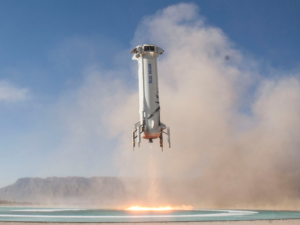
An Updated Look At Blue Origin’s BE-4 Engine
Over one decade ago in 2011, Blue Origin began development on the BE-4 engine. Since then, while the engine program most certainly had a few hiccups along the way, Blue Origin continued to develop and test the engine. Now in late 2022, the first flight BE-4s are only months away from their maiden launch at the bottom of ULA’s Vulcan Centaur.
In addition to this upcoming milestone, Blue Origin recently announced that dozens of these engines are now in production to support a large and growing demand for various future launches. This increase in production will be necessary considering not one but two next generation launch vehicles rely on BE-4. Both New Glenn and Vulcan need these engines for the majority of thrust on the first stage.
If Blue Origin wants to continue providing these future rockets with propulsion, an increase in development and testing speed is needed. Not to mention, the results of Vulcan’s first flight could have both very positive and negative effects on BE-4’s future timeline. Here I will go more in-depth into the recent BE-4 progress, Blue Origin’s development and testing process, what to expect in the future, and more.
Recent Updates

Now more than ever we are receiving more information on Blue Origin’s BE-4 engine and some of the progress it has made. Just about one month ago on October 31st, Blue Origin tweeted saying, “The first shipset. The first of many. #BE4 flight engines are now being integrated into the @ulalaunch #VulcanRocket.” By now in early December, these two flight engines are not only installed on Vulcan but practically ready for testing. Over the past couple of months, Blue Origin and Tory Bruno provided updates on Flight engines #1 and #2 as they went through the initial manufacturing and testing process. Over the next few weeks, we can expect more information from ULA as they test both the integrated BE-4 engines on Vulcan in preparation for the first launch. If the tests show promising results then only a few months from now we will watch both these BE-4 engines in action for the first time on an official launch.
There are two main outcomes of this upcoming mission that will have a big effect on Blue Origin and the future of BE-4. The first and most likely is that everything goes to plan and Vulcan successfully lifts off. In this case, Blue Origin and ULA would receive a lot of invaluable information on the engines and exactly how they performed during the launch. From here, the company’s main focus would need to be significantly increasing the speed of development and testing of the BE-4. On the other hand, if something were to go wrong on this initial flight or in the upcoming testing related to the BE-4, it would most defiantly stall the engine program as Blue Origin works to figure out exactly what went wrong and ensure it doesn’t happen again in the future.
In addition to BE-4s progress related to Vulcan, recently Blue Origin also released some new information regarding additional BE-4 development and work. Specifically, the company was quoted saying, “Dozens of these engines are now in production to support a large and growing demand for civil, commercial, and defense launches.” This is quite a big deal as Blue Origin has by no means been the fastest when working on BE-4 over the last few years. This being said, Rocket engines are immensely complex rocket components that play an equally important job. However, this news from the company is a good sign as the development and testing speed of BE-4 is one of the main problems that could hurt two future launch vehicles. While Vulcan only needs two BE-4s on the first stage, New Glenn requires 7. With Vulcan already practically launching and New Glenn expected to begin testing not too long from now, these engines will be in very high demand.
To put the timeline of these two Vulcan flight BE-4 engines in perspective, we can look back in time to earlier this year and see the amount of progress that was made. For example, back in early June, Tory Bruno tweeted mentioning, “The flight BE4s are in the assembly stand @blueorigin. Here’s a view from the upper platform of one of the pair with the very cool additively manufactured GOX dome installed.” This included an image of one of the bare-bones flight engines. At this point in time, Vulcan was still expected to launch in 2022 and Tory Bruno was confident that the engines would be delivered soon. For example in this specific tweet replies, when asked when he thought the engines would be delivered to ULA, Tory responded “Mid year “. By now we know that it took about 5 months for the engines to be delivered in late October.
BE-4 Overview

Now that we know more about what progress the BE-4 engine is making and some of its important upcoming events, we can take a closer look at the engine itself and how it applies to two next generation launch vehicles. Blue Origin highlights that operationally reusable rockets demand high performance engines capable of deep throttling for soft landings. Built for multiple uses, their family of engines is trying to power the next generation of rockets for commercial, civil, national security, and human spaceflight. These engines are designed, developed, and manufactured at the company’s headquarters in Kent, Washington. Currently, they are preparing for serial production of their most powerful engine, the BE-4, in Huntsville, Alabama.
Each BE-4 engine provides 550,000 pounds of thrust and has completed an extensive development program. Blue Origin is confident that this state-of-the-art engine will end reliance on Russian engines and power a new generation of U.S. launch vehicles. One of the most unique aspects of this engine is its use of liquid oxygen and liquid natural gas which we are seeing more of around the industry. In Blue Origin’s case, they chose LNG because it is highly efficient, low cost, and widely available. Unlike kerosene, LNG can be used to self-pressurize its tank. Known as autogenous repressurization, this eliminates the need for costly and complex systems that draw on Earth’s helium reserves. LNG also possesses clean combustion characteristics even at low throttle, simplifying engine reuse compared to kerosene fuels. An important feature considering New Glenn’s booster is hoping to be reused 25 times.
In relation to this engine, after the first shipset was delivered, both Tory Bruno and Blue Origin’s CEO had a few things to say. Tory Bruno said, “We are very pleased to receive the first two engines for Vulcan’s inaugural flight. Development of this new engine is complete, and the performance of the engine is outstanding. It has been a great team effort working together with our partners at Blue Origin and we can’t wait to see Vulcan fly.” In addition, Bob Smith, CEO of Blue Origin commented, “We’re excited to see ULA’s Vulcan fly. The BE-4 is a great engine, and we’re proud of Team Blue for achieving this milestone as part of ULA’s team. It’s been a wonderful partnership, and this shipset is the first of many more to come.” BE-4 was designed from the beginning to be a medium-performing version of a high-performance architecture. It’s a conscious design choice made to lower development risk while attempting to meet performance, schedule, and reusability requirements.
In terms of future launch vehicles, propulsion technology is foundational to the New Glenn program. New Glenn benefits from more than a decade of engine and related technology development at Blue Origin. For New Glenn’s first stage, Blue Origin will use the BE-4, a 2,400 kN(550,000 lbf) sea level thrust booster engine. New Glenn is a single configuration heavy-lift launch vehicle with the goal of carrying people and payloads routinely to Earth orbit and beyond. Featuring a reusable first stage built for 25 missions, it will utilize 7 BE-4 engines crucial for main thrust and complex landing maneuvers. The restartable BE-4 engines provide precision thrust vector control and continuous deep throttle capability to support propulsive deceleration and landing maneuvers, while featuring long design life. The 8.5 m (28 ft) diameter engine skirt protects the engines from atmospheric reentry conditions and contains six (6) stowed landing gear.
As for Vulcan, in late 2014, Blue Origin signed an agreement with United Launch Alliance to co-develop the BE-4 engine and to commit to using the new engine on the Vulcan launch vehicle, a successor to the Atlas V, which would replace the Russian-made RD-180 engine. Since early 2015, the BE-4 had been in competition with the AR1 engine for the Atlas V RD-180 replacement program. While the BE-4 is a liquified natural gas engine, the AR1, like the RD-180, is kerosene-fueled. In February 2016, the US Air Force issued a contract that provides partial development funding of up to US$202 million to ULA in order to support the use of the Blue BE-4 engine on the ULA Vulcan launch vehicle. This leads us to today with the first launch only months away scheduled in the first quarter of 2023.
Conclusion
The BE-4 has had many ups and downs over its development beginning in 2011. While there have been quite a few delays, the first two flight engines have been delivered and are installed on Vulcan. Not to mention comments from the company highlighting that they are increasing production. We will have to wait and see how it progresses and the impact it has on the space industry.



